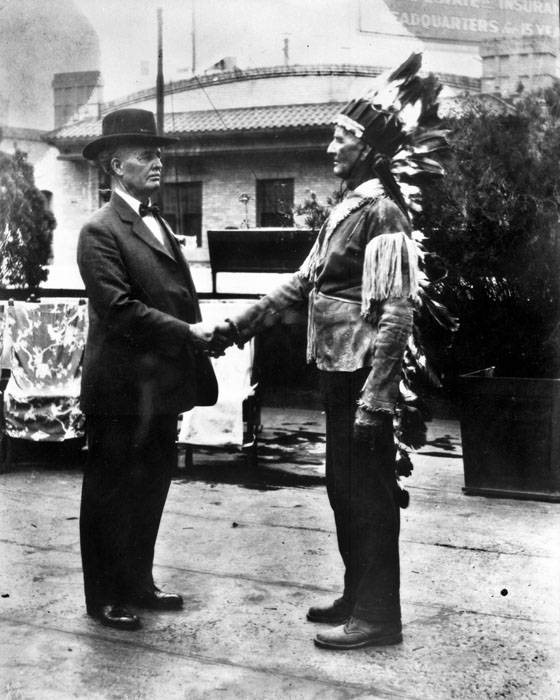
The German Texans- Entry One -Hermann Lehmann, Indian Captiveby: Kevin J. Klaus
Hermann Lehmann and Former Texas Ranger Capt. James Buchanan
If you travel the scenic back roads between the towns of Llano, Mason, past the community of Loyal Valley, and down to Fredericksburg today, you might be impressed with the picturesque landscapes, of sleepy hills and valleys and large cattle ranches that occupy the region. But more than one hundred and fifty years ago, it was much different, the German immigrants were being settled into Fredericksburg, and further North into what would be known as the Fisher Miller Colony. This area was also home at one time to roaming bands of Native Americans such as the Apache and Comanche. While the Germans in Fredericksburg had coexisted in relative peace by establishing a Treaty with the Comanches on May 9th, 1847,1 the Apache were still something to be feared as they were known to attack settlements, kill or steal livestock, or capture settlers to adopt into their tribe. One such unfortunate incident happened to the son of Moritz and Johanna Lehman near Loyal Valley in Mason County.2 Johanna Lehman had lost her husband in 1864 she then married Philip Buchmeyer in 1866. The family settled upon a small preemption grant in Mason County On May 16th, 1870, young Hermann Lehmann who was eleven years old was working in the fields with his brother and two sisters when an Apache raiding party of eight to ten men captured Hermann and his younger brother William. The sisters were able to escape capture and tell the story of what happened once they returned home. Four days after being captured, William Lehmann escaped when the raiding party encountered and fought a skirmish with a mounted patrol of Buffalo Soldiers, while young Hermann remained with his captors.3 Herman was quickly assimilated into Apache culture and rough life after being told that his family had been killed. For six years he lived on the wild frontier ranging from Central Texas to Eastern New Mexico. He was initiated into primitive tribal life to become a warrior and hunted buffalo. He was involved with a running battle against the Texas Rangers on August 24th, 1875 near Fort Concho.4 Around the spring of 1876, life would change for him, when his adopted Apache father Carnoviste was killed.5 Out of revenge Hermann killed an Apache medicine man and fled the tribe fearing he would be killed. For a year he wandered in the wilderness until he happened upon a camp of Comanche Indians. Herman observed the camp for some time before entering the camp under the cover of night. The Comanche did not accept him initially and threatened to kill him until another Indian brave came forward to verify his story of killing the Apache medicine man.6 He stayed on with the Comanche and in 1877 was involved with several battles such as attacks against buffalo hunters on the high plains of Texas or when his camp was attacked at Yellow House Canyon near present day Lubbock, raids against the Tonkawa’s and United States Cavalry. 7 He was among the last group of Comanche to surrender and later moved to the reservation at Fort Sill Oklahoma. During his time in Oklahoma, Hermann Lehmann became acquainted and was befriended by Quanah Parker. He disliked being in captivity at Fort Sill, in his view “that was the end of Indian ways, our free, roving times which we loved. We were one of the very last tribes to come in.”8 While there, he was recognized as being a white captive and returned to his family in Texas in 1878. However, his reintroduction into white society, meeting his mother Johanna and siblings, relearning his German culture, even sleeping in a bed was difficult and he never fully adapted. Eventually he did settle down in Loyal Valley Texas and married twice and raised a family. He was well liked in the community and somewhat of a local celebrity in the Texas Hill Country performing at public exhibitions of his riding, roping feats or skill with a bow and arrow, and story telling. In the later part of his life he met with many of the old Texas Rangers who he had fought against while he lived with the Comanche’s or Apache’s. He passed away on February 2nd, 1932, and is buried in the community of Loyal Valley Texas.9
1 Glen E. Lich, The German Texans. Denton:University Institute of Texan Cultures at San Antonio, 1981. p. 54. 2 Land Grant for Philip Buchmeyer, Bex-P-479, Original Land Grant Collection, Archives and Records Program, Texas General Land Office, Austin. 3 Handbook of Texas Online, A. C. Greene, Lehmann, Hermann," accessed April 19, 2016, http://www.tshaonline.org/handbook/online/articles/fle26. Uploaded on June 15, 2010. Published by the Texas State Historical Association. 4 Wikipedia, the free encyclopedia. "Herman Lehmann," Accessed April 11, 2016, https://en.wikipedia.org/wiki/Herman_Lehmann. last modified on 25 March 2016. 5 Handbook of Texas Online, A. C. Greene, Lehmann, Hermann," accessed April 19, 2016, http://www.tshaonline.org/handbook/online/articles/fle26. Uploaded on June 15, 2010. Published by the Texas State Historical Association. 6 Wikipedia, the free encyclopedia. "Herman Lehmann," Accessed April 11, 2016, https://en.wikipedia.org/wiki/Herman_Lehmann. last modified on 25 March 2016. 7 Wikipedia, the free encyclopedia. "Herman Lehmann," Accessed April 11, 2016, https://en.wikipedia.org/wiki/Herman_Lehmann. last modified on 25 March 2016. 8 Glen E. Lich, The German Texans. Denton:University Institute of Texan Cultures at San Antonio, 1981. p. 96. 9 Handbook of Texas Online, A. C. Greene, Lehmann, Hermann," accessed April 19, 2016, http://www.tshaonline.org/handbook/online/articles/fle26. Uploaded on June 15, 2010. Published by the Texas State Historical Association. Links: Guide to the German Collection in the Texas General Land Office by Kevin J. Klaus Click here for PDF of this entry
|
